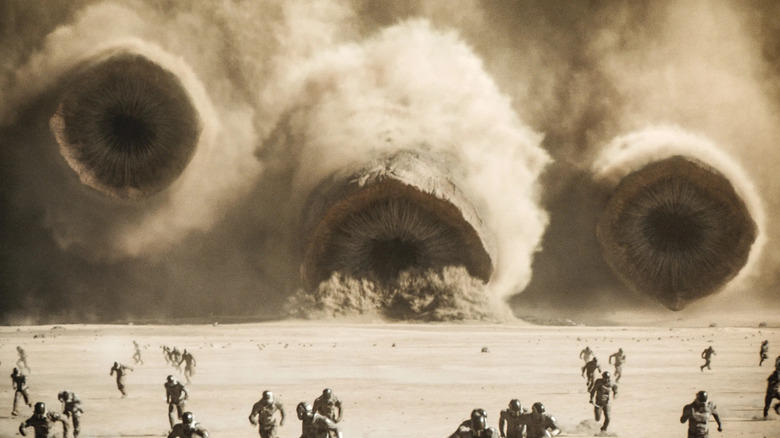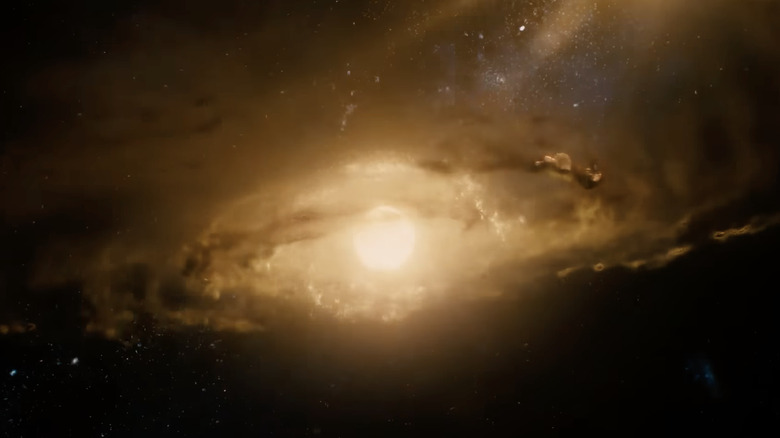First Ideas For Dune's Opening Scenes Would Have Eaten Up The Entire Movie Budget
For many years, Frank Herbert's "Dune" saga was described as impossible to adapt. Oh, people tried (check out our ranking of the "Dune" movies/TV here), but it wasn't until director Denis Villeneuve's two recent "Dune" films (with a third movie forthcoming) that one of these efforts was acclaimed. (David Lynch's 1984 "Dune" has its defenders, but it tanked upon release.) Villeneuve went from making a sequel to "Blade Runner" to adapting a story deemed a white whale. You can't say he doesn't have ambition, but even he has his limits.
Speaking to IndieWire in 2022, "Dune" screenwriter Eric Roth described his original pitch for the movie's opening sequence. Essentially, it was the Book of Genesis, Arrakis edition: "I started the movie with what would seem to be 'Genesis — 'and God created'— and you think you're seeing the formation of the Earth. And it's Dune, with wild animals, things you've never seen."
Roth remembered Villeneuve's answer, "This is magnificent, but now we can't afford the rest of the movie." Roth jokes this may have just been Villeneuve shooting the idea down with veiled logistical concerns, but evidence suggests the filmmaker didn't want to blow up the bank. With the first film being untested and "Blade Runner 2049" bombing at the box office, Villeneuve probably wasn't in a position to demand Warner Bros. do so either.
"Dune" had a budget of $165 million, on the lower side for a blockbuster these days. Then, "Dune: Part Two" had a reported budget of $190 million, only $25 million higher than the first movie, despite the evident vote of confidence from producers.
This is a sign of a filmmaker who doesn't want to spend more than he has to.
How was planet Dune created?
"Dune" instead opens with a more immediate prologue. Paul (Timothée Chalamet) dreams of Chani (Zendaya), who explains the history of Arrakis; how the brutal Harkonnens occupy the planet for its spice mines (space travel fuel), leaving her people — the native Fremen — marginalized. This was the better choice; the mythology of "Dune" is already complex, so when introducing it to the audience, it is better to narrow the story's scope.
From a logistical standpoint, the flourishes of the finalized opening (the Fremen and Harkonnen costumes, the CGI models of spaceships, etc.) are ones that would be used throughout the movie. With Roth's idea, the film would had to have designed countless CGI creature models that would only be used for that opening scene.
If you want an idea of what Eric Roth's opening might have looked like, watch Darren Aronofsky's "Noah" (seen above), inspired by the Biblical story of the Great Flood. In a two-minute montage, the film depicts the history of the universe; stars blinking into being, Earth cooling from the primordial fire, and life sprouting from its oceans. A fish who exits the water walks across the landscape, evolving into a different creature with every jump cut before it becomes man. Throughout the sequence, Noah (Russell Crowe) narrates for his children with descriptions from the Book of Genesis, suggesting how God's invisible guiding hand could have crafted our world.
The success of "Dune: Part Two" means we likely have the next big movie franchise on our hands, especially with "Dune Messiah" already in the works. If Villeneuve and his eventual successors are so inclined, they should have the opportunity to explore the history of planet Arrakis — or as the Fremen once called it, Dune.
"Dune: Part Two" is currently still playing in theaters.

